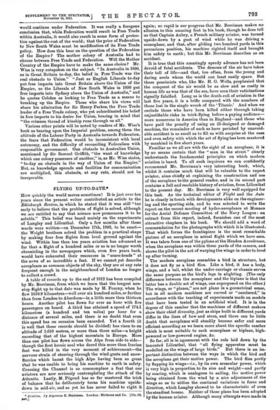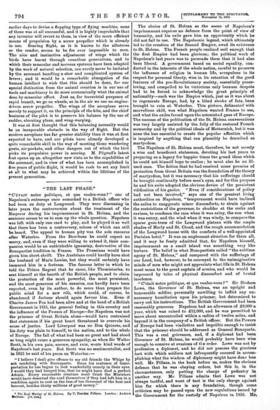FLYING UP-TO-DATE.* How quickly the world moves sometimes! It is
just over• ten years since the present writer contributed an article to the Edinburgh Review, in which he stated that it was still "too early to believe that the problem of flight is solved, although we are entitled to say that science now pronounces it to be soluble." This belief was based mainly on the experiments of Langley and Lilienthal. Only a few months after these words were written—on December 17th, 1903, to be exact— the Wright brothers solved the problem in a practical shape by making four free flights from level ground against the wind. Within less than ten years aviation has advanced so far that a flight of a hundred miles or so is no longer worth chronicling in the newspapers which, even five years back, would have exhausted their resources in " scare-heads " at the news of so incredible a feat. If we cannot yet describe aeroplanes as common objects of the sky, they are at any rate frequent enough in the neighbourhood of London no longer to collect a crowd.
A table of records up to the end of 1912 has been compiled by Mr. Berriman, from which we learn that the longest non- stop flight up to that date was made by M. Fourny, when he flew 1010.9 kilometres—well over six hundred miles, or further• than from London to Aberdeen—in a little more than thirteen hours. Another pilot has flown for over an hour with five passengers on board. A third has attained a speed of 174.1 kilometres (a hundred and ten miles) per hour for• a distance of several miles, and there is no doubt that even this speed has on occasion been exceeded. Yet a fourth (it is well that these records should be divided) has risen to an altitude of 5,610 metres, or more than three miles—a height exceeding that of the highest mountain in Europe. More than one pilot has flown across the Alps from side to side— though the first heroic soul who dared this more than Icarian feat was killed in the very moment of achievement—the nervous strain of steering through the wind•gusts and snow- flurries which haunt the high Alps having been so great that he was unable to bring his machine to earth in safety. Crossing the Channel is so commonplace a feat that our aviators are now seriously contemplating the attack of the Atlantic. Lastly, M. Pegoud has so far mastered the trick of balance that he deliberately turns his machine upside- down in mid-air•, and as yet he has never failed to right it
• Arialion. Py Algernon E. Berriman. London : Methuen and Co. [10s. 6d. Pet.]
again; so rapid is our progress that Mr. Berriman makes no allusion to this amazing feat in his book, though he does tell us that Captain Aubry, a French military aviator, was turned upside-down by a gust of wind while he was driving a monoplane, and that, after gliding two hundred yards in this precarious position, his machine righted itself and brought him safely to earth ; but this Mr. Berriman describes as an accident.
It is true that this amazingly speedy advance has not been devoid of fatal accidents. The demons of the air have taken their toll of life—and that, too often, from the young and daring souls whom the world can least easily spare. But those pessimists who, like Mr. H. G. Wells, prophesied that the conquest of the air would be as slow and as costly in human life as was that of the sea, have seen their vaticinations signally falsified. Long as is the death-roll of aviation in the last five years, it is a trifle compared with the numbers of those lost in the single wreck of the ' Titanic.' And when we exclude those who have been killed either through taking unjustifiable risks in trick-flying before a paying audience— more numerous in America than in England—and those who have paid the penalty of using an ill-designed or damaged machine, the remainder of such as have perished by unavoid- able accident is so small as to fill us with surprise at the ease and even safety with which the ar•t of flying has been mastered by mankind in five short years.
Familiar as we all are with the sight of an aeroplane, it is by no means certain that the " man in the street " clearly understands the fundamental principles on which modern aviation is based. To all such inquirers we can confidently recommend Mr. Berriman's very interesting book, which, whilst it contains much that will be valuable to the expert aviator, aims chiefly at explaining the construction and use of the aeroplane to the general reader, and in its second part contains a full and readable history of aviation, from Lilienthal to the present day. Mr. Berriman is very well equipped for this task. As the technical editor of Flight and the Auto he is closely in touch with developments alike on the engineer- ing and the sporting side, and he was selected to write the report on the recent meeting of hydro-aeroplanes at Monaco for the Aerial Defence Committee of the Navy League : an extract from this r•epor•t, indeed, furnishes one of the most attractive chapters in his book. We should add a word of commendation for• the photographs with which it is illustrated. That which forms the frontispiece is the most remarkable picture of an aeroplane in actual flight which we have seen. It was taken from one of the pylons at the Hendon Aerodrome, when the aeroplane was within three yards of the camera, and shows the pilot in the act of warping the wings in order to level up after• turning.
The modern aeroplane resembles a bird in structure, but it does not fly as a bird flies. Like a bird, it has a body, wings, and a tail, whilst the under-carriage or chassis serves the same purpose as the bird's legs in alighting. (The only difference between the monoplane and the biplane is that the latter has a double set of wings, one superposed on the other.) The wings, or "planes," are not plane in a geometrical sense, but in all modern machines ar•e curved or "cambered," in accordance with the teaching of experiments made on models that have been tested in an artificial wind. It is in the degree of this camber that the machines of different makers show their chief diversity, just as ships built in different yards differ in the lines of bow and stern, and there can be little doubt that aeroplanes will steadily become safer and more efficient according as we learn more about the specific camber which is most suitable to each monoplane or• biplane, high- powered or low-powered engine, &c.
So far, all is in agreement with the rule laid down by the lamented Lilienthal, that " all flying apparatus must be modelled on the wings of large birds." But there is an im- portant distinction between the ways in which the bird and the aeroplane get their motive power. The bird flies partly by flapping its wings—i.e., by its own muscular power, which is very high in proportion to its size and weight—and partly by soaring, which is analogous to sailing, the motive power being obtained from the wind by a nice adjustment of the wings so as to utilize the continual variations in force and direction, which Langley showed to be characteristic of even the steadiest breeze. Neither of these plans has been adopted by the human aviator. Although many attempts were made in earlier days to devise a flapping type of flying machine, none of these was at all successful, and it is highly improbable that any inventor will revert to them, in view of the more efficient means of propulsion by a screw propeller which is already in use. Soaring flight, as it is known to the albatross or the condor, seems to be for ever impossible to man. The nice and instinctive adjustment of wings which the birds have learnt through countless generations, and to which their muscular and nervous systems have been adapted by the work of natural selection, can surely never be imitated by the aeronaut handling a slow and complicated system of levers ; and it would be a remarkable abnegation of the human intellect to wish that this should be done, for our special distinction from the animal creation is in our use of tools and machinery to do more economically what the animal does by muscular effort. Just as, for terrestrial purposes of rapid transit, we go on wheels, so in the air we use an engine- driven screw propeller. The wings of the aeroplane serve merely to support it, on the principle of the kite, and the chief business of the pilot is to preserve his balance by the use of rudder, elevating plane, and wing-warping.
It was at first thought that this balancing necessity would be an insuperable obstacle in the way of flight. But the modern aeroplane has far greater stability than it was at first expected to have, and our pilots have already developed a quite remarkable skill in the way of meeting those wandering gusts, air-pockets, and other dangers out of which the bird picks its propulsive power in soaring. M. Pegoud's latest feat opens up an altogether new vista as to the capabilities of the aeronaut, and in view of what has been accomplished in five years of public flight, it would be rash to set any limit at all to what may be achieved within the lifetime of the present generation.































































 Previous page
Previous page